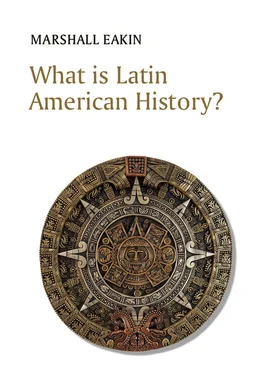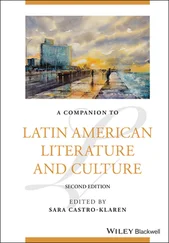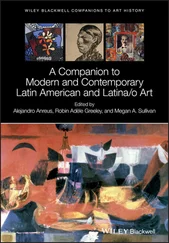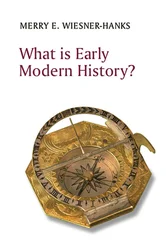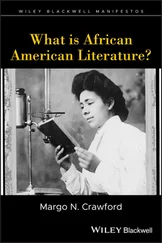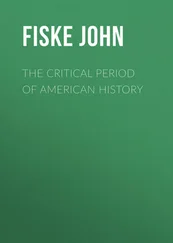Marshall Eakin - What is Latin American History?
Здесь есть возможность читать онлайн «Marshall Eakin - What is Latin American History?» — ознакомительный отрывок электронной книги совершенно бесплатно, а после прочтения отрывка купить полную версию. В некоторых случаях можно слушать аудио, скачать через торрент в формате fb2 и присутствует краткое содержание. Жанр: unrecognised, на английском языке. Описание произведения, (предисловие) а так же отзывы посетителей доступны на портале библиотеки ЛибКат.
- Название:What is Latin American History?
- Автор:
- Жанр:
- Год:неизвестен
- ISBN:нет данных
- Рейтинг книги:4 / 5. Голосов: 1
-
Избранное:Добавить в избранное
- Отзывы:
-
Ваша оценка:
- 80
- 1
- 2
- 3
- 4
- 5
What is Latin American History?: краткое содержание, описание и аннотация
Предлагаем к чтению аннотацию, описание, краткое содержание или предисловие (зависит от того, что написал сам автор книги «What is Latin American History?»). Если вы не нашли необходимую информацию о книге — напишите в комментариях, мы постараемся отыскать её.
What is Latin American History? — читать онлайн ознакомительный отрывок
Ниже представлен текст книги, разбитый по страницам. Система сохранения места последней прочитанной страницы, позволяет с удобством читать онлайн бесплатно книгу «What is Latin American History?», без необходимости каждый раз заново искать на чём Вы остановились. Поставьте закладку, и сможете в любой момент перейти на страницу, на которой закончили чтение.
Интервал:
Закладка:
By the eighteenth century, those of Spanish descent born in the Americas increasingly referred to themselves as creoles ( criollos ) to distinguish themselves from Spaniards born in Spain but residing in the Americas ( peninsulares ). Although those of Portuguese descent in Brazil were cognizant of their differences with those born in Portugal, the social distinctions were less pronounced than those between the criollos and peninsulares . Europeans and Euro-Americans sometimes referred to their regions as América española or América portuguesa . As the Euro-Americans fought to break with their colonial masters in the early nineteenth century, they contrasted themselves with the Europeans and began to call themselves americanos or, in the case of the Spanish colonies, hispano-americanos .
The violent break with Spain and Portugal, and the fitful emergence of about fifteen new nations by the 1840s, confronted the leaders of the wars for independence with the need to construct names, symbols, and rituals for the nations and nationalities they sought to create out of the fragments of the collapsing colonial empires. Simón Bolívar, the great liberator of northern South America, dreamed of forging a confederation of the former colonies as one great American nation. Disillusioned, dying, and heading off into exile in late 1830, he could see that his dream had failed, and he concluded that “America is ungovernable” and that “He who serves the revolution ploughs the sea.” When he spoke of America, he clearly meant the former Spanish colonies as a whole (and not the United States or Brazil). While most of the new leaders focused on constructing their own nation-states, some intellectuals took Bolívar’s larger view and envisioned a region with a common cultural identity, if not a political one.
The first documented usage of the term Latin America (in Spanish and French), ironically, emerges in France in the 1850s and 1860s in a series of essays by French, Colombian, and Chilean intellectuals. 2In part, the term served to contrast Spanish (and sometimes French and Portuguese) America from the growing power of the United States, what these intellectuals called Anglo-Saxon America. Intellectuals and diplomats in the region envisioned a Latin race defined by its cultural heritage of languages (derived from Latin) and religion (Catholicism) opposed to the aggressive and increasingly imperialist, Protestant Anglo-Saxons in the United States. From the French perspective, the effort to stress common cultural bonds between the old Spanish, French, and Portuguese colonies (“Latin” peoples) also served to help justify Napoleon III’s imperial ambitions in the Americas, especially his invasion of Mexico in the 1860s. France had also become, by the mid-nineteenth century, the most important cultural influence on the newly ascendant national elites, and that cultural captivation helped to bolster the rationale among intellectuals in the region for adopting the name.
Multiple ironies permeated the creation and then gradual adoption of the name Latin America. First, and most striking, the vast majority of peoples living in the region in the mid-nineteenth century were Native Americans (especially in Mexico, Central America, and the Andes), Afrodescendants (especially in the Caribbean basin and Brazil), and the racially and culturally mixed. In places such as Mexico, Central America, and the Andes, the indigenous majority did not even speak a “Latin” language. Euro-American elites created the Latin modifier as the politically and culturally hegemonic group, but it represented an aspiration, not a reality on the ground. These intellectuals created “Latin” America as a contrast to “Anglo-Saxon” America (the United States), another term that is also deeply ironic. Despite the massive influx of Europeans into North America, even in the 1850s, nearly one in seven inhabitants of the United States was an enslaved person of African descent, native peoples were numerous, and large percentages of the Euro-Americans were neither Anglo-Saxons nor Protestants! As immigration accelerated in the late nineteenth century, the largest waves of immigrants came not from England but from the European continent, especially Southern and Eastern Europe. The misguided creole elites who sought to create Latin American nations had mislabeled both their own region and the United States. It was a false and flawed dichotomy from its inception, but one that would have a long life.
As a small but vibrant scholarly community developed in the United States at the beginning of the twentieth century, the term Latin America began to appear in book titles and essays. When this group of scholars created their own journal during the First World War, Latin America remained but one possible term for the region. They debated among themselves and finally settled on the Hispanic American Historical Review (not the Latin American Historical Review ), arguing that the term “Hispanic” also encompassed Portuguese Brazil. It was not until the end of the Second World War that the term Latin America became the most common for the region south of the United States. In the aftermath of the world war and the emergence of the Cold War, for strategic purposes, the U.S. defense and security community divided up the globe. Much of this terminology became standardized in the National Defense Education Act of 1958, a direct response to the perceived threat of the Soviet Union and the launching (in 1957) of Sputnik, the first artificial satellite to circle the Earth. The Act aimed to build up U.S. higher education (especially in math and science) to confront the challenges of the Cold War, especially from the Soviet Union. The legislation led to the creation of “national resource centers” and “area studies” fellowships funded by the federal government to develop expertise in the various regions of the world. Along with centers for the study of Russia and Eastern Europe, Asia, Africa, and other world regions, the government began funding centers for Latin American studies. 3
Our current conception of Latin America has its strongest roots in the efforts of foundations and government agencies to “map” world regions in the post-1945 era. The National Research Council, the American Council of Learned Societies, and the Smithsonian Institution formed the Ethnogeographic Board in the 1940s. Through their work, and especially after the passage of the National Defense Education Act, (as with the intelligence and defense communities) academia in the United States carved up the world into regions or areas and universities scrambled to organize “area studies” centers. Latin America, with its seemingly dominant Iberian linguistic, political, and cultural traditions, was one of the most clearly coherent world regions. In many ways, it is a more coherent region than “Europe” or “Southeast Asia,” with their multiple languages and ethnicities. In the words of José Moya, the region is “the largest contingent area in the world bound by similar legal practices, language, religion, naming patterns, and the arrangement of urban space.” 4Latin American area studies programs faced dilemmas from their inception in how to deal with “non-Latin” regions and populations, especially in the Caribbean basin (particularly the British West Indies and U.S. territories) and areas that once formed part of the Spanish empire in the Americas, but eventually came under control of the British, the French, the Dutch, and the United States. 5
The confusion about the boundaries and scope of the region can be seen in the variety of names for Latin American centers in the United States. Some are simply Latin American centers or institutes. Others have been centers for Iberoamerican studies or Latin American and Caribbean studies or centers for Latino and Latin American studies (to include those of Latin American heritage in the United States). At times, some of these centers have been broad enough to be centers for the Americas (as a whole) or transatlantic (Latin American and Iberian studies). Those fifteen or so “national resource centers” receiving government funding are required by law (whatever their name may be) to spend their funds only on “Latin American” programming, that is, not on Latin Americans and their descendants in the U.S. or on the English- or French-speaking Caribbean. The U.S. government very specifically defines the region as the Spanish-speaking nation-states south of the United States (thus excluding Puerto Rico), Brazil, and Haiti.
Читать дальшеИнтервал:
Закладка:
Похожие книги на «What is Latin American History?»
Представляем Вашему вниманию похожие книги на «What is Latin American History?» списком для выбора. Мы отобрали схожую по названию и смыслу литературу в надежде предоставить читателям больше вариантов отыскать новые, интересные, ещё непрочитанные произведения.
Обсуждение, отзывы о книге «What is Latin American History?» и просто собственные мнения читателей. Оставьте ваши комментарии, напишите, что Вы думаете о произведении, его смысле или главных героях. Укажите что конкретно понравилось, а что нет, и почему Вы так считаете.
